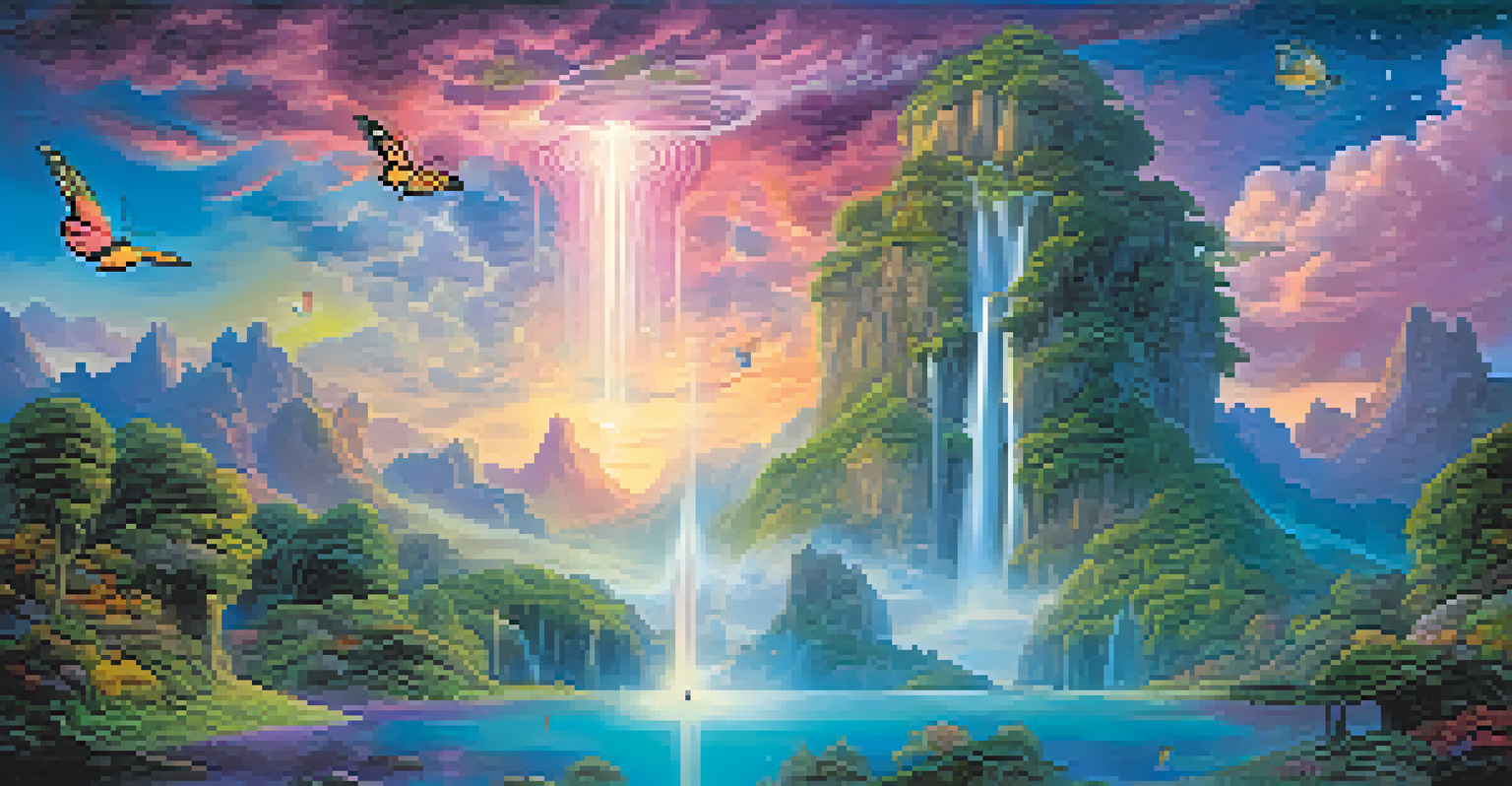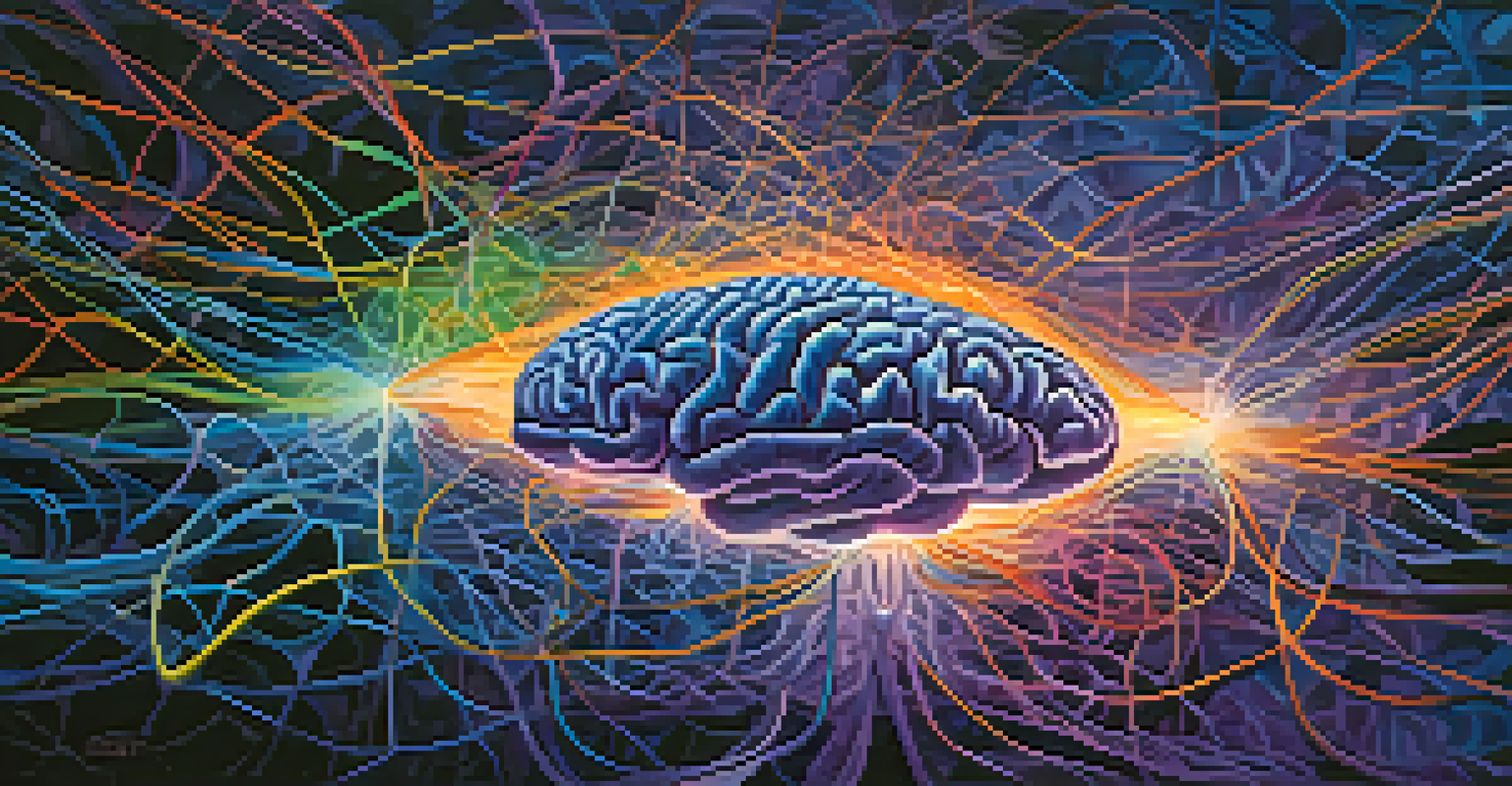The Connection Between REM Sleep and Hallucinogenic States

Understanding REM Sleep: The Dream State
REM sleep, or Rapid Eye Movement sleep, is a unique phase of the sleep cycle where most dreaming occurs. It typically happens about 90 minutes after falling asleep, and the brain becomes highly active while the body remains still. This state is characterized by rapid movement of the eyes, increased heart rate, and enhanced brain activity, resembling wakefulness.
Dreams are the touchstones of our character.
During REM sleep, the brain processes emotions, consolidates memories, and fosters creativity. It's like a nightly workshop, where the mind stitches together various experiences into a coherent narrative. This is why people often wake up with vivid memories of their dreams, which can range from mundane to fantastical.
Interestingly, this phase of sleep is crucial for emotional regulation and cognitive functioning. A lack of REM sleep can lead to irritability and difficulty concentrating. Just as we need food and water, our brains thrive on the restorative powers of REM sleep.
Hallucinogenic States: A Brief Overview
Hallucinogenic states can be described as altered perceptions of reality, often induced by substances like LSD, psilocybin mushrooms, or even certain plants. These experiences can lead to vivid visual and auditory hallucinations, as well as a profound sense of connection to the universe. The brain undergoes significant changes in its chemical makeup during these experiences.

Interestingly, hallucinogens work by interacting with serotonin receptors in the brain, particularly the 5-HT2A receptor. This interaction can create a sense of euphoria, altered perception of time, and even mystical experiences. It's as if the mind is temporarily rewired, allowing for new connections and insights.
REM Sleep Fuels Creativity and Emotion
During REM sleep, the brain actively processes emotions and consolidates memories, akin to a nightly workshop for creativity.
While the effects of hallucinogens can vary widely from person to person, they often share similarities with dreams experienced during REM sleep. Both states can lead to surreal experiences and a heightened sense of awareness, which raises the question of how they might be interconnected.
The Brain's Chemistry: Neurotransmitters at Play
At the heart of both REM sleep and hallucinogenic experiences are neurotransmitters, the brain's chemical messengers. During REM sleep, levels of neurotransmitters like acetylcholine surge, while serotonin and norepinephrine dip. This unique cocktail creates the ideal conditions for vivid dreams and emotional processing.
The greatest discovery of my generation is that a human being can alter his life by altering his attitude.
On the flip side, hallucinogens like LSD predominantly affect serotonin pathways, particularly the aforementioned 5-HT2A receptors. This overlap in neurotransmitter activity suggests that the brain may be tapping into similar mechanisms when experiencing dreams and hallucinogenic states. It's like two different paths leading to the same breathtaking vista.
Understanding how these chemicals interact can provide insight into why some people experience profound insights or emotional breakthroughs during both REM sleep and hallucinogenic experiences. The brain seems to thrive on the exploration of altered states, revealing the depths of human consciousness.
Commonalities Between REM Sleep and Hallucinations
Both REM sleep and hallucinogenic states share remarkable similarities, particularly in the vividness and emotional intensity of experiences. Many individuals report that their dreams can feel as real as waking life, with rich sensory details and complex narratives. Similarly, hallucinogenic experiences can evoke strong feelings and vivid imagery.
Another common thread is the sense of altered perception. During REM sleep, individuals might find themselves in fantastical scenarios that defy logic, much like hallucinations induced by psychedelics. This blurring of reality can evoke feelings of wonder, fear, or enlightenment, depending on the individual's mindset.
Hallucinogens Alter Perception
Hallucinogenic substances interact with brain chemistry, creating altered states that evoke vivid experiences similar to those in REM sleep.
Additionally, both states can lead to a sense of connection with oneself and the universe. Many people describe feeling as if they are part of a greater whole during these experiences, whether in a dream or under the influence of hallucinogens. This profound connection may provide insights into the nature of consciousness itself.
The Role of the Default Mode Network (DMN)
The Default Mode Network (DMN) is a group of brain regions that are active when we are at rest and not focused on the outside world. It's involved in self-referential thoughts, daydreaming, and recalling memories. Interestingly, both REM sleep and hallucinogenic states have been shown to alter the activity of the DMN.
During REM sleep, the DMN becomes highly active, facilitating the dream experience and allowing for a narrative to unfold. In contrast, hallucinogens can disrupt the typical connectivity patterns within the DMN, leading to unique experiences that often transcend normal consciousness. This can create a feeling of ego dissolution, where the boundaries between self and environment blur.
Understanding the DMN's role in these altered states can shed light on how our brains navigate between reality and imagination. It suggests that both REM sleep and hallucinogenic experiences are not just random occurrences but rather essential components of our cognitive and emotional landscape.
Potential Therapeutic Implications
The intriguing connection between REM sleep and hallucinogenic states has sparked interest in their therapeutic potential. Recent research suggests that both could play a role in treating mental health conditions like PTSD, depression, and anxiety. By exploring these altered states, researchers aim to unlock new pathways for healing.
For instance, studies have shown that REM sleep can help process traumatic memories, while hallucinogens have been linked to significant reductions in anxiety and depression among terminally ill patients. This indicates that harnessing the benefits of both states could lead to innovative therapeutic approaches.
DMN Connects Dreams and Hallucinations
The Default Mode Network plays a crucial role in both REM sleep and hallucinogenic experiences, linking self-referential thoughts and imagination.
As scientists continue to unravel the complexities of the brain, the integration of REM sleep and hallucinogenic experiences may pave the way for groundbreaking treatments. Imagine a future where we can utilize our natural sleep cycles and the power of psychedelics to enhance mental well-being.
Conclusion: Bridging the Gap Between Dreams and Reality
The connection between REM sleep and hallucinogenic states provides a fascinating glimpse into the workings of the human mind. Both experiences allow us to explore the depths of our consciousness, revealing insights that can be both profound and transformative. As we continue to study these altered states, we may uncover new understandings of our psyche.
By recognizing the similarities between dreaming and hallucinogenic experiences, we open the door to potential therapies that can help individuals heal from emotional wounds. The brain's ability to traverse these landscapes shows that the boundaries between reality and imagination are more fluid than we once thought.

Ultimately, the relationship between REM sleep and hallucinogens reminds us of the power of our minds. Whether through the lens of dreams or altered states of consciousness, we are continually exploring what it means to be human.